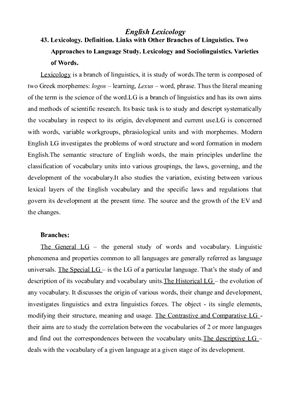Выходные данные неизвестны.
Lexicology. Definition. Links with Other Branches of Linguistics.
Two Approaches to Language Study. Lexicology and Sociolinguistics.
Varieties of Words.
Semasiology. Word-Meaning. Referential Approach to Meaning. Functional Approach to Meaning. Types of Meaning. Denotational and Connotational Meaning. Emotive Charge. Stylistic Reference.
Word-Meaning and Meaning in Morphemes. Lexical Meaning. Part-of-speech Meaning. Differential Meaning. Distributional Meaning.
Word-Meaning and Motivation. Change of Meaning. Causes of Semantic Change. Nature of Semantic Change. Results of Semantic Change.
Meaning and Polysemy. Semantic Structure of Polysemantic Words. Diachronic Approach. Synchronic Approach. Historical Changeability of Semantic Structure. Polysemy and Homonymy.
Homonymy of Words and Homonymy of Word-Forms. Classification of Homonyms. Graphic and Sound-Form of Homonyms. Sources of Homonymy. Polysemy and Homonymy.
Meaning Relations in Paradigmatics and Semantic Classification of Words. Semantic Fields. Hyponymic Structures and Lexico-semantic Groups. Semantic Equivalence and Synonymy. Criteria of Synonymity. Pattes of Synonymic Sets in Mode English. Semantic Contrasts and Antonymy. Semantic Similarity of Morphemes and Word-Families.
Word groups and phraseological units. Lexical Valency. Grammatical Valency. Structure of Word-Groups. Distribution as a Criterion of Classification. Meaning of Word-Groups.
Phraseological Units. Free Word-Groups, Versus Set-Phrases. Phraseological Units, Idioms,Word-Equivalents. Criteria of Stability and Lack of Motivation. Classification. Phraseological Units and Idioms. Phraseology as a Subsystem of Language.
Word-Structure. Segmentation of Words into Morphemes. Types of Word Segmentability. Classification of Morphemes. Morphemic Types of Words.
Word-Formation. Various Ways of Forming Words. Various Types and Ways of Forming Words. Word-Formation. Definition. Basic Peculiarities. Productivity of Word-Formation Means.
Affixation. Definition. Degree of Derivation. Prefixal and Suffixal Derivatives. Prefixation. Some Debatable Problems. Classification of Prefixes. Suffixation. Main Principles of Classification.
Conversion. Definition. Synchronic Approach. Typical Semantic Relations. Basic Criteria of Semantic Derivation. Diachronic Approach of Conversion. Origin. Productivity. Traditional and Occasional Conversion. Conversion and Sound-(Stress-) Interchange.
Word-Composition. Compounding. Structure. Meaning. Structural Meaning of the Patte. The Meaning of Compounds. Motivation. Classification. Relations between the ICs of Compounds. Different Parts of Speech. Means of Composition. Types of Bases. Correlation between Compounds and Free Phrases. Correlation Types of Compounds. Sources of Compounds.
Minor types of word formation. Clipping. Blending. Abbreviation. Sound interchange. Sound imitation. Back formation. Distinct stress.
Replenishment of Mode English Vocabulary. Development of Vocabulary. Structural and Semantic Peculiarities of New Vocabulary Units.
Ways and Means of Enriching the Vocabulary. Productive Word-Formation. Various Ways of Word-Creation. Borrowing. Semantic Extension
Fundamentals of English Lexicography. Main Types of English Dictionaries. Encyclopaedic and Linguistic Dictionaries. Classification of Linguistic Dictionaries. Explanatory Dictionaries. Translation Dictionaries. Specialised Dictionaries.
Semasiology. Word-Meaning. Referential Approach to Meaning. Functional Approach to Meaning. Types of Meaning. Denotational and Connotational Meaning. Emotive Charge. Stylistic Reference.
Word-Meaning and Meaning in Morphemes. Lexical Meaning. Part-of-speech Meaning. Differential Meaning. Distributional Meaning.
Word-Meaning and Motivation. Change of Meaning. Causes of Semantic Change. Nature of Semantic Change. Results of Semantic Change.
Meaning and Polysemy. Semantic Structure of Polysemantic Words. Diachronic Approach. Synchronic Approach. Historical Changeability of Semantic Structure. Polysemy and Homonymy.
Homonymy of Words and Homonymy of Word-Forms. Classification of Homonyms. Graphic and Sound-Form of Homonyms. Sources of Homonymy. Polysemy and Homonymy.
Meaning Relations in Paradigmatics and Semantic Classification of Words. Semantic Fields. Hyponymic Structures and Lexico-semantic Groups. Semantic Equivalence and Synonymy. Criteria of Synonymity. Pattes of Synonymic Sets in Mode English. Semantic Contrasts and Antonymy. Semantic Similarity of Morphemes and Word-Families.
Word groups and phraseological units. Lexical Valency. Grammatical Valency. Structure of Word-Groups. Distribution as a Criterion of Classification. Meaning of Word-Groups.
Phraseological Units. Free Word-Groups, Versus Set-Phrases. Phraseological Units, Idioms,Word-Equivalents. Criteria of Stability and Lack of Motivation. Classification. Phraseological Units and Idioms. Phraseology as a Subsystem of Language.
Word-Structure. Segmentation of Words into Morphemes. Types of Word Segmentability. Classification of Morphemes. Morphemic Types of Words.
Word-Formation. Various Ways of Forming Words. Various Types and Ways of Forming Words. Word-Formation. Definition. Basic Peculiarities. Productivity of Word-Formation Means.
Affixation. Definition. Degree of Derivation. Prefixal and Suffixal Derivatives. Prefixation. Some Debatable Problems. Classification of Prefixes. Suffixation. Main Principles of Classification.
Conversion. Definition. Synchronic Approach. Typical Semantic Relations. Basic Criteria of Semantic Derivation. Diachronic Approach of Conversion. Origin. Productivity. Traditional and Occasional Conversion. Conversion and Sound-(Stress-) Interchange.
Word-Composition. Compounding. Structure. Meaning. Structural Meaning of the Patte. The Meaning of Compounds. Motivation. Classification. Relations between the ICs of Compounds. Different Parts of Speech. Means of Composition. Types of Bases. Correlation between Compounds and Free Phrases. Correlation Types of Compounds. Sources of Compounds.
Minor types of word formation. Clipping. Blending. Abbreviation. Sound interchange. Sound imitation. Back formation. Distinct stress.
Replenishment of Mode English Vocabulary. Development of Vocabulary. Structural and Semantic Peculiarities of New Vocabulary Units.
Ways and Means of Enriching the Vocabulary. Productive Word-Formation. Various Ways of Word-Creation. Borrowing. Semantic Extension
Fundamentals of English Lexicography. Main Types of English Dictionaries. Encyclopaedic and Linguistic Dictionaries. Classification of Linguistic Dictionaries. Explanatory Dictionaries. Translation Dictionaries. Specialised Dictionaries.

